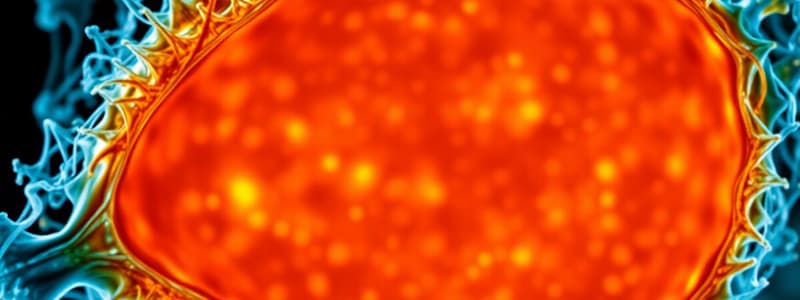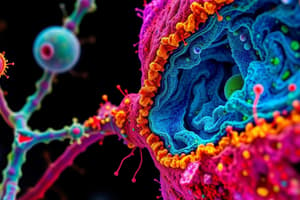Podcast
Questions and Answers
Which of the following best describes the function of special fluorescent dyes in fluorescence microscopy?
Which of the following best describes the function of special fluorescent dyes in fluorescence microscopy?
- Locating specific molecules within the specimen by binding to them. (correct)
- Increasing the resolution of the image.
- Magnifying the specimen beyond the capabilities of standard light microscopy.
- Creating a black background to enhance contrast.
Among the light microscope designs, which one is specifically adapted for viewing cells in flasks or deep containers?
Among the light microscope designs, which one is specifically adapted for viewing cells in flasks or deep containers?
- Inverted microscope (correct)
- Digital microscope
- Compound microscope
- Stereo microscope
In the context of microscopy, what is the primary advantage of a stereo microscope?
In the context of microscopy, what is the primary advantage of a stereo microscope?
- Providing a three-dimensional view of the specimen. (correct)
- Capturing and recording moving images via computer software.
- Achieving high magnification up to 1000X.
- Using electron beams to visualize specimens at the nanometer scale.
What is the key feature that distinguishes a digital microscope from other types of light microscopes?
What is the key feature that distinguishes a digital microscope from other types of light microscopes?
Which of the applications listed is most closely associated with the use of electron microscopy?
Which of the applications listed is most closely associated with the use of electron microscopy?
What is the fundamental principle behind electron microscopy that enables it to achieve much higher resolutions than light microscopy?
What is the fundamental principle behind electron microscopy that enables it to achieve much higher resolutions than light microscopy?
A researcher needs to examine the surface features of a virus particle in high detail. Which type of microscopy would be most appropriate?
A researcher needs to examine the surface features of a virus particle in high detail. Which type of microscopy would be most appropriate?
In which scenario would an inverted microscope be MOST advantageous compared to a standard compound microscope?
In which scenario would an inverted microscope be MOST advantageous compared to a standard compound microscope?
Which characteristic is NOT a limitation of bright field microscopy when observing unstained biological specimens?
Which characteristic is NOT a limitation of bright field microscopy when observing unstained biological specimens?
In dark field microscopy, how is the light path manipulated to enhance the visibility of unstained specimens?
In dark field microscopy, how is the light path manipulated to enhance the visibility of unstained specimens?
What is the KEY principle behind fluorescence microscopy that enables the detection of specific molecules within cells?
What is the KEY principle behind fluorescence microscopy that enables the detection of specific molecules within cells?
What is the primary function of the barrier filter in fluorescence microscopy?
What is the primary function of the barrier filter in fluorescence microscopy?
A researcher is studying the motility of bacteria. Which type of microscopy would be most suitable for observing the bacteria's movement in a natural state without staining?
A researcher is studying the motility of bacteria. Which type of microscopy would be most suitable for observing the bacteria's movement in a natural state without staining?
A researcher aims is to visualize the location of a specific protein within a cell using a fluorescently labeled antibody. Which microscopy technique is most appropriate?
A researcher aims is to visualize the location of a specific protein within a cell using a fluorescently labeled antibody. Which microscopy technique is most appropriate?
Why do unstained specimens typically exhibit poor contrast under a bright field microscope?
Why do unstained specimens typically exhibit poor contrast under a bright field microscope?
If a specimen is viewed under a dark field microscope, and appears as a bright object against a dark background, what can be inferred about the light's interaction with the specimen?
If a specimen is viewed under a dark field microscope, and appears as a bright object against a dark background, what can be inferred about the light's interaction with the specimen?
Flashcards
Light Microscopy (LM)
Light Microscopy (LM)
Uses light passing through a specimen and magnifying lenses to view the sample.
Electron Microscopy (EM)
Electron Microscopy (EM)
Uses electrons to visualize a specimen, offering higher magnification and resolution than light microscopy.
Bright Field Microscope (BFM)
Bright Field Microscope (BFM)
The most common type of light microscope, where the field is bright and the specimen appears dark.
Dark Field Microscopes (DFM)
Dark Field Microscopes (DFM)
Signup and view all the flashcards
Bright field microscope character
Bright field microscope character
Signup and view all the flashcards
Bright field microscope advantage
Bright field microscope advantage
Signup and view all the flashcards
Dark field microscopy
Dark field microscopy
Signup and view all the flashcards
Fluorescence Microscope
Fluorescence Microscope
Signup and view all the flashcards
Compound Light Microscope
Compound Light Microscope
Signup and view all the flashcards
Inverted Microscope
Inverted Microscope
Signup and view all the flashcards
Stereo Microscope
Stereo Microscope
Signup and view all the flashcards
Digital Microscope
Digital Microscope
Signup and view all the flashcards
Transmission Electron Microscope (TEM)
Transmission Electron Microscope (TEM)
Signup and view all the flashcards
Scanning Electron Microscope (SEM)
Scanning Electron Microscope (SEM)
Signup and view all the flashcards
Study Notes
- Microscopes are essential tools for cell biologists.
- This tutorial provides a brief overview of the types of microscopes commonly used in biological studies.
- The two broad categories of microscopy are Light Microscopy (LM) and Electron Microscopy (EM).
Types of Microscopes
Light Microscopy
- Light microscopy uses sunlight or an artificial light source.
- Types of light microscopes:
- Bright field microscope
- Dark field microscope
- Epi-fluorescence microscopy
Electron Microscopy
- Electron Microscopy uses electrons.
- Types of electron microscopes:
- Transmission Electron Microscope (TEM)
- Scanning Electron Microscope (SEM)
Light Microscopy
- Light passes through the specimen and then through a series of magnifying lenses.
- It is the simplest type of microscope.
- Microscopes are of great importance in studying microorganisms and biomolecules.
Bright Field Microscopes (BFM)
- These are the most common general-use microscopes.
- The microscopic "field" is bright, while the object viewed is dark.
- It has a simple design.
- Light directed at the specimen is absorbed to form an image.
- Unstained specimens have poor contrast, while stained specimens show excellent contrast.
- These Microscopes are Ideal for stained bacteria, cells, and tissues.
- Bright Field Microscopes features high resolution.
Dark Field Microscopes (DFM)
- These microscopes create a dark background to allow viewing of small unstained objects, such as motile bacteria, which would be difficult to view in a bright field.
- The central portion of light is blocked; only diagonal light strikes the specimen and forms the image.
- Feature a bright specimen and a dark background
Fluorescence Microscopy
- Detects molecules and ions within cells.
- Fluorescent dyes absorb short wavelengths of light and emit longer wavelengths.
- Barrier filters and a prism select the excitation wavelength that strikes the specimen and then exclude the excitation wavelength from the detector, allowing only emitted light to reach the detector (oculars).
- Uses a UV light source, creating a high-resolution image.
- Special fluorescent dyes are used to locate "molecules" in a specimen.
- This type of microscope features a black background and a bright-stained specimen.
Designs of Light Microscopes
- Compound microscope
- Inverted microscope
- Stereo microscope
- Digital microscope
Compound Light Microscope
- Commonly binocular (two eyepieces).
- The eyepiece itself allows for 10X or 15X magnification.
- When combined with three or four objective lenses that can be rotated into the field of view, it produces a generally higher magnification to a maximum of around 1000X.
Inverted Microscopes
- The basic bright field microscope design has been modified for special uses.
- Inverted microscopes allow viewing of cells in flasks, welled-plates, or other deep containers that do not fit between the objectives and stage of standard Bright Field microscopes.
Stereo Microscope
- Has two optical paths at slightly different angles, allowing the image to be viewed three-dimensionally under the lenses.
- Magnifies at low power, typically between 10X and 200X.
Digital Microscope
- Uses the computer's power to view objects not visible to the naked eye.
- The computer software allows the monitor to display the magnified specimen.
- Moving images can be recorded or single images captured in the computer's memory.
Electron Microscopy
- Electron Microscopes (EM) are powerful microscopes available to researchers and allows them to view a specimen at nanometer size.
- This type of microscope uses electrons to create an image of the target.
- Electron Microscopes have practical applications in biology, chemistry, gemology, metallurgy, and industry.
- Used in biomedical research to investigate the detailed structure of tissues, cells, organelles, and macromolecular complexes.
- The two common types are Transmission Electron Microscope (TEM) and Scanning Electron Microscope (SEM).
Studying That Suits You
Use AI to generate personalized quizzes and flashcards to suit your learning preferences.



